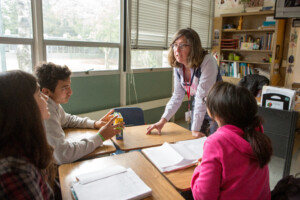Education, State Policy and the Future of Work

As the future of work continues to increase in uncertainty, and as the change we see in the world continues to accelerate, many of us will agree that it can feel as though our education system is struggling to maintain an at-best-moderate pace of adapting to the world around it.
There are numerous reasons for this, including but not limited to: the challenge of identifying ways to develop systems of accountability around the sometimes-nebulous traits, skills and dispositions that the future workforce will demand; a lack of adequate resources to develop high-quality career-ready high schools; and even the challenge of getting traditional schools and districts on board with the types of nuts-and-bolts changes required to provide student-centered learning. Unfortunately, the results of this lack of progress can be seen across the spectrum of post-secondary readiness surveys.
These are the challenges the XQ Institute (you may be familiar with their Super School Project) seeks to address in their new report, released September 10 and titled High School & the Future of Work: A Guide for State Policymakers. The guide argues that, to prepare students for an uncertain and technology-driven future, state policymakers should be looking for ways to increase flexibility for those seeking to provide students with learning experiences that are more competency-based, more project-based, and more attached to the real world. It focuses on providing strategies for how they can do so equitably.
 This focus on equity is a core aspect of their recommendations. Flexibility and student-centered learning, XQ argues (and we agree), can be a boon to underserved and disadvantaged students. “Redefining what it means to be prepared and opening up new ways for high school students to meet that definition should mean getting more serious about standards and accountability, not less,” they argue.
This focus on equity is a core aspect of their recommendations. Flexibility and student-centered learning, XQ argues (and we agree), can be a boon to underserved and disadvantaged students. “Redefining what it means to be prepared and opening up new ways for high school students to meet that definition should mean getting more serious about standards and accountability, not less,” they argue.
A few of our favorite points in the guide are the following:
- “Many educators see the problems, but every time they try a different approach, they run into at least one rule that stops them. In particular, rigid requirements around “seat time” stop in their tracks many of the most creative efforts to get students outside their classrooms into workplaces and other venues where they can learn by tackling real-world problems.” (p.8)
- “Just as no two students are the same, no two communities are the same. So why should our high schools be? Real progress occurs when local communities are empowered to design their own solutions to the common challenge of ensuring that all students—regardless of background—graduate prepared for success after high school.” (p.22)
- “For many students today, a high school diploma lacks the meaning it should have. The route to earning a diploma is too often unengaging, uninspiring, and unchallenging. And, once obtained, a diploma doesn’t guarantee that the graduate has mastered essential knowledge, skills, and competencies and has a viable pathway to the jobs of the future.” (p.30)
- “States can maintain high standards and college-ready coursework requirements while opening up room for innovation in high school teaching and learning. One way to do that is by revising the formal definition of a high school “course” to broaden the ways in which students can learn and demonstrate their learning in order to earn credits and, ultimately, a diploma.” (p.37)
Perhaps the most important aspect of the guide is the way in which it builds meaningful policy recommendations off of these high-level and future-oriented perspectives of what secondary education can and should be. Every one of the aforementioned stances is backed up by equity-focused strategies for policymakers that can ensure that these changes happen meaningfully for all students.
We’ve been working closely with XQ to rethink the high school credential, and this guide is an important contribution to the ongoing national conversation. We very much recommend reading through this guide and sharing it with your policymaker friends.
And, if you like what you read, keep an eye out for the competency-based landscape report we’ll be releasing with XQ in October.
For more, see:
- 18 Examples of State Policies that Support Competency-Based Programs
- Rethinking the High School Credential
- Building 21: Designing a Network for Competency-Based Education
Stay in-the-know with all things edtech and innovations in learning by signing up to receive the weekly Smart Update. This post includes mentions of a Getting Smart partner. For a full list of partners, affiliate organizations and all other disclosures, please see our Partner page.






0 Comments
Leave a Comment
Your email address will not be published. All fields are required.